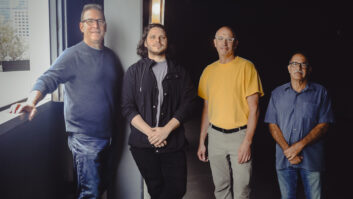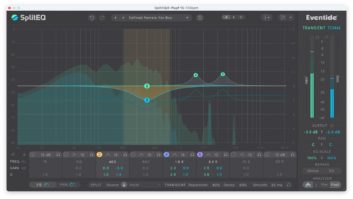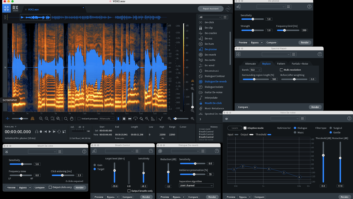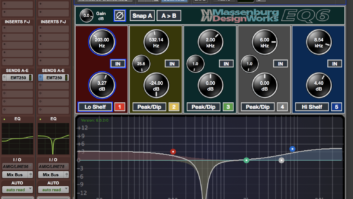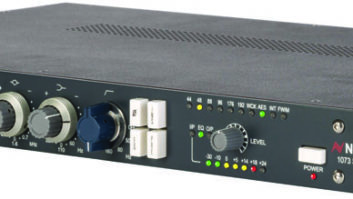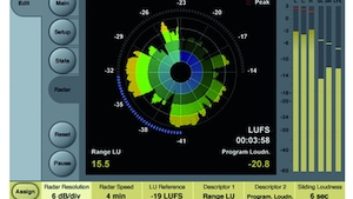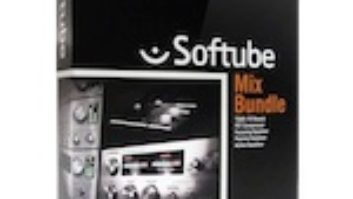EQs: We all need them, and most of us have a lot of them — both in our racks and on our computers. Engineers have various criteria for choosing between hardware and software effects, ranging from value to convenience to, most importantly, sound quality, but even some self-professed analog processing devotees are finding it hard to resist the plug-in temptation. As virtual EQs sonically improve, they continue to offer ease of use and flexibility that their outboard ancestors just can’t match.
“I’m more of an outboard gear guy, not really a plug-in guy,” prefaces Neal Pogue, the Grammy-winning producer/engineer known for his work with OutKast and, most recently, Stevie Wonder. But he does have quite a few favored plug-ins in his arsenal. “When I use something,” he says, “I use it because I really like it. When a plug-in version of something sounds really good, that’s when I’ll use it.”
Jeff Coplan, producer/engineer/songwriter and owner of New York — based Subsonic Studios, admits he’s turned into more of an “inboard guy.” “There’s no doubt that I’d prefer to use a good hardware-based EQ over any plug for the pure sound of it,” he says. “However, the advantages of being able to automate your EQ plugs are huge. Definitely the speed, recall factor and simplicity of working within my workstation are advantages.”
Pogue and Coplan still regularly lean toward their favorite outboard EQs, even when considering the operational advantages that equalization within their workstations provide. “There’s no plug-in I’ve heard that has the low-end punch of one of my Neve 1073s or 1081s, not to mention the beautiful highs of a Tube-Tech PE1C or even an Avalon VT-737SP,” offers Coplan. “Even if I’m mixing directly in Pro Tools, I will always insert out to my hardware EQs for at least the kick, snare, bass and lead vocal.”
From top: Elemental Audio Systems Firium, Waves Q-Clone, Wave Arts TrackPlug 5 and Massenburg DesignWorks MDW
But even this rule can be broken when the benefits of using plug-based EQ make the impossible happen. “I just finished mixing a record that I didn’t track that had three — and sometimes four or five — lead vocalists per song,” Coplan recalls. “Each had a different tone. Often throughout the song, they’d sing really hard to really soft, making their tone change dramatically. It would have been incredibly difficult to mix it without EQ plugs. Each track had to have its own EQ setting that often was automated to change throughout the song as their tones changed.”
If you’re considering going virtual with your EQ, then check out the following plug-in guide. To keep this list somewhat concise, only what could be considered traditional — or operationally traditional — EQ apps are listed. None of the free (yet highly capable) equalizers bundled with DAW packages are here, nor are any virtual instrument add-ons, sound design tools with EQ parameters and so on — only products whose main purpose is equalization. Dig in!
ANWIDA Soft (www.anwida.com) offers a collection of graphic and parametric equalizers — including the GEQ15V 15-band and GEQ31V 31-band graphics — in a variety of bundle configurations. Most notable is the PEQ1V ($69), a parametric EQ featuring a constant Q, minimum phase equalization algorithm. The PEQ1V includes 24-bit/96kHz audio support and 64-bit internal precision for its high/low shelving and four parametric peak/notch filter sections. Other features include parameter automation, preset change automation, factory presets and stereo output. Three operational formats — VST/Windows, VST/Mac OS X and SAWStudio — are offered.
Blue Cat’s Music Software (http://software.bluecatonline.org) offers a half-dozen EQs designed for VST and DirectX platforms on Windows OS. Blue Cat’s Liny EQ, a 9-band linear phase equalizer, offers a wide range (±40 dB) of gain per band. Like all Blue Cat EQs, the Liny operates with no latency and features auto-gain compensation, “smooth update” mechanism for modifying parameters in real time, random preset of parameters and full automation support. Parametr’EQ is a 7-band parametric equalizer featuring a low-shelf filter, high-shelf filter and five boost/cut peak filters. It also offers a ±40dB gain range and wide bandwidth: 0.01 to 5 octaves. Both EQs are available in stereo and “Widening” versions. Available for purchase directly from Blue Cat’s Website, the Liny EQ, Liny Stereo and Liny Widening are priced at $15, $20 and $30, respectively. The Parametr’EQ, Stereo Parametr’EQ and Widening Parametr’EQ are available for $15, $25 and $35, respectively.
Bomb Factory‘s (dist. by Digidesign, www.digidesign.com) Pultec Bundle ($595) is about as close as a discriminating Pro Tools — based engineer can get to Pultec equalizers without heat sinks or maintenance needs. The GUIs look and behave just like the tube boxes from which they were modeled. The three-EQ bundle — featuring re-creations of Pultec EQP-1A and EQH-2 program equalizers and the MEQ-5 midrange equalizer — are built for use with Windows XP and Mac OS X — based Pro Tools DAWs, supporting TDM HD|Accel, TDM HD, TDM MIX, RTAS and AudioSuite systems. Featuring the VC5 Meequalizer, Bomb Factory’s Joemeek Bundle ($395) for Pro Tools is an affordable and flexible plug-in for Mac and Windows. Also including the SC2 Photo Optical Compressor, Joemeek Bundle’s VC5 Meequalizer re-creates the EQ circuit in the original Meek-designed EQ, a treble and bass EQ with sweepable mids.
DUY‘s (www.duystore.com) MagicEQ ($295) mastering equalizer is an extremely simple plug-in to use: It will automatically equalize a mix itself, allowing further user modification after the initial analysis. How does it work? Using three unique technologies — OFIR (Optimal Frequency Impulse Renderer), ASM (Adaptive Spectral Matching) and HAS (Historical Audio Statistics) — MagicEQ users click a Learn button, and the selected audio information will be analyzed. Afterward, the user can adjust the amount of EQ effect to be added to the original sound and make further adjustments via four Spectral Atmospheres knobs. Five controls adjusting five bands — sub-low, low, mid, high and ultra-high — are also available to dial in exact desired EQ effect.
Audio production software company Elemental Audio Systems (www.elementalaudio.com) offers two EQ plug-ins: Firium and Eqium. Both are Mac OS X and Windows XP — compatible and 88.2/96/192k-ready, and all native plug-in formats (Mac RTAS/VST/AudioUnits and Windows RTAS/VST) are included. Firium is a linear phase EQ that “builds a complex FIR (Finite Impulse Response) filter” to the user’s specifications and is designed to not color audio via nonlinear phase shift. Its spectrum-matching feature allows frequency response to be analyzed and applied to another sound source. Two workspaces and comprehensive histories allow comparison of EQ settings, and adjustments of ±18 dB are allowed. Unlimited bands or filters are Eqium’s appeal, which lets users create as many bands as needed. Features include boost/cut of ±24 dB, two workspaces, filter graph zoom for detailed editing, flexible activating of filters on-the-fly and much more. Elemental’s EQ Bundle featuring Firium and Eqium is priced at $169 and is available directly from the company’s Website.
Focusrite‘s (www.focusrite.com) Forte Suite ($595) is essentially a classic Focusrite Forte analog console for use in Pro Tools|HD Accel DAW systems up to 192 kHz. Along with a compressor, gate and expander, the Forte Suite offers the original 6-band equalizer from the Forte desk. The scalable plug-in offers a complete channel strip, a stereo version of every module and several 5.1 processing settings. TDM, RTAS and Audio Suite formats are supported.
IK Multimedia‘s (www.t-racks.com) T-RackS plug-in for Mac OS and Windows DAWs features four processors including a 6-band parametric equalizer, a stereo compressor/leveler, multiband master stereo limiter and an adjustable soft-clipping output stage. T-RackS’ algorithms are based on analog circuitry, thus its vintage selection of sounds. In the latest version of T-RackS’ EQ, full-band sweepable mid-bands are included, which allow both peaking filters to cover a 20 to 20k Hz frequency range. T-RackS lists for $399, while a complete IK Multimedia bundle featuring T-RackS with AmpliTube and SampleTank 2 XL is priced at $799.
From top: McDSP Channel G, Sony Oxford EQ and Universal Audio Pultec Pro
Kjaerhus Audio (www.kjaerhusaudio.com) has a full line of Windows-only audio plug-ins, including two EQs. The stereo GEQ-2 ($98) is a 5-band parametric with a selectable shelf on the high and low band and low- and high-cut filters with selectable slopes. Four EQ “styles” are provided. Other features include full VST automation, sampling rates to 192 kHz, 64-bit internal processing, A/B comparison, separate L/R adjustment and no latency. The Classic Series EQ (available for free) is a simple 7-band stereo equalizer featuring Warm and Saturation algorithms. Stereo link, VU meter, full VST automation and separately adjustable L/R channels are included. Both models are available exclusively at the Kjaerhus Website. A trial license period of 14 days is available.
Levelground Media (www.levelgroundmedia.com) offers a unique EQ plug-in called the CrunchEQ, which combines a 10-band graphic and 5-band parametric within one equalizer. The CrunchEQ’s Crunch feature allows the application adjustment of mild distortion algorithms on any given signal. Other features of this Mac OS X — based plug-in include a global sharpness adjustment on the graphic EQ; frequency, sharpness and amplitude adjustment on the parametric; and a Curve Excenuator for the application of different EQ styles to audio samples. The CrunchEQ V. 1.1 DSP is $79.
Attention DAW tweakers: Massenburg DesignWorks (www.massenburg.com), George Massenburg’s plug-in company, has an EQ just for you. The MDW ($795) high-resolution parametric EQ for Pro Tools|HD features 48-bit/96kHz, “double-precision” processing, wide frequency selection from 10 to 41k Hz, selectable bands, constant shape reciprocal curves and an intuitive design.
McDSP‘s (www.mcdsp.com) Channel G ($995) and FilterBank ($495) are flexible options for those looking to emulate EQ from basically every equalizer in existence. The stand-alone EQ configuration of Channel G offers modes styled after API, SSL and Neve channel EQs, while FilterBank allows the emulation of any shelving EQ’s response curves. The Channel G EQ (designed to be a standard channel strip path for the Digidesign ICON console) offers five bands of parametric equalization, switchable shelving, gain ranges of ±18 dB and two multimode filters. Other parameters include an expander/gate, a compressor/limiter, filters and a 5.1 compressor/limiter, among others. FilterBank offers 20 plug-ins of 2, 4 and 6-band EQs and filters in both mono and stereo versions. With all EQ and filter design parameters fully user-adjustable, FilterBank can model existing processors or be used for custom effects.
Version 2.1 of Metric Halo‘s (www.mhlabs.com) ChannelStrip — featuring 6-band fully parametric 48-bit EQ (64-bit for native) and six selectable filter band types — is a compatibility update that now operates with Pro Tools 7 TDM, LE and M-Powered systems. ChannelStrip for Pro Tools 7 is available directly from Metric Halo’s Website for $699, TDM/RTAS; and $345, native.
Nomad Factory‘s (www.nomadfactory.com) Essential Studio Suite ($379) and Blue Tubes ($399) bundles include one and three EQs, respectively. In addition to eight other plugs, the Essential Studio Suite features the Essential Graphic EQ, a 15-band equalizer with adjustable bandwidth and brick-wall limiter. The bundle is Mac-based and TDM, RTAS, VST (Mac/PC) and AudioUnits-compatible. The Blue Tubes bundle includes 16 tube-style plugs for PC and Mac OS X DAWs that feature intuitive GUIs. The BT Equalizer PEQ-2A offers low-shelf, high-shelf and mid-peak EQ controls. Each band offers ±20dB boost/cut and selectable frequency. The BT Equalizer PEQ-2B is a “classic ’60s EQ” with a low-frequency section allowing low-shelf boost and attenuation. Its high-frequency section provides boost/cut and bandwidth controls for a center frequency. The BT Equalizer PEQ-2C is a classic midrange EQ with high/low peak boost controls, a mid-frequency attenuator to create a vintage EQ curve.
Professional Sound Projects‘ (www.pspaudioware.com) MasterQ ($149), a parametric equalizer designed for mastering applications, is also useful on individual instruments. The MasterQ features seven filters with adjustable frequency and Q over a wide range and a detailed display of the EQ curve and each filter’s setting. The MasterQ operates at sampling rates from 44.1 to 192 kHz, and is available for VST/DirectX for PC, and AudioUnits, VST and RTAS for Mac OS X.
The Rane Series Pro Tools|HD TDM and Digidesign VENUE plug-ins from Serato (www.serato.com) are based on Rane’s hardware EQs for live sound. The Rane Series Graphic EQ offers the features of the DEQ 60/60L in an easy-to-use GUI, with 31 bands of equalization, three bands of overall tone control, a low- and high-cut filter pair and a color-coded response graph for overall gain and phase change display. The Rane Series Parametric EQ re-creates the comprehensive feature set of the PEQ 55 and is similarly intuitive. Like the PEQ 55, this plug offers 10 bands of parametric EQ, movable from 12.5 to 20k Hz, all independently switchable from high to low shelf or bell filters. The plugs support sample rates up to 192 kHz and can be used in mono, stereo and multi-mono modes.
Originally designed for use within the OXF-R3 digital console, the Sony (www.sonyplugins.com) Oxford EQ ($850) is available as a plug-in for Pro Tools|HD users. A 5-band equalizer, the Oxford EQ includes selectable shelf settings on low- and high-frequency sections, separate variable slope lowpass and highpass filters, four different EQ types and a seemingly endless list of features. An optional GML 8200 Emulation, co-designed by George Massenburg and Sony, offers the performance of GML’s original hardware-based 8200 parametric EQ.
SpinAudio Software (www.spinaudio.com), makers of Windows plug-ins with flexible GUIs, offers the SpinEQ, a multiband parametric stereo equalizer available as a 4- and 10-band version. Operational in four modes — Mono, Stereo Equal, Stereo-Linked and Stereo-Free — the SpinEQ features five filter types per band, along with filter frequency, gain and Q adjustment. Its Visual Equalizer Control feature provides visible feedback and easy control over various filter parameters. The SpinEQ is a part of the Essential Plug-Ins Bundle, available directly from SpinAudio for $95.
Universal Audio (www.uaudio.com), known for modern recreations of classic outboard gear, also makes plug-ins designed to appear and sound as if their DAW-based users are clicking the large black knobs of a vintage audio processor. Case in point: the Pultec EQP-1A Program Equalizer and Pultec Pro. The EQP-1A ($249 for TDM) is a re-creation of the original Pultec Program EQ, while the Pultec Pro ($149 for UAD-1) combines the Pultec MEQ-5 midrange EQ and the EQP-1A into one single plug-in. Either EQ section within the Pultec Pro can be separately enabled/disabled. The new Precision EQ plug-in ($199 for UAD-1) is a stereo/dual-mono 4-band parametric equalizer and highpass filter designed for program material use. Four bands of filtering are grouped in overlapping pairs: two for lows, two for highs. A ±8dB shelving or peak/notch filter is available for each band, with five peak/notch responses per band. The Cambridge EQ ($249, TDM; $149, UAD-1), a “console-style” 5-band equalizer, features switchable parametric or shelving parameters and two high- and lowpass filters. Advanced editing features are included, as well as detailed adjustment of gain, resonance and each frequency band on its graphic “front panel” display. All of these EQs come together in the UAD-1 Ultra PAK bundle for $1,199. (The Pultec Pro, Precision EQ and Cambridge EQ can be selected for the UAD-1 Flexi PAK, which offers fewer, but interchangeable, plug-in options for $899.)
For those who crave classic API, Pultec and Neve EQs for their DAW-based projects, URS (www.ursplugins.com) has plenty of options. The URS A Series ($499, TDM; $249, native) is a digital re-creation of the API 550B 4-band equalizer, and the complementary A10 Series ($499, TDM; $299, native) is an API-style, 10-band fixed EQ. The URS FullTec Program EQ ($499, TDM; $249, native) is — surprise, surprise — a Pultec-style 5-band equalizer that accurately re-creates the desired parameters of the Pultec EQP-1. URS’ N Series — the “N” stands for Neve — features two great EQ plugs: the 5-band “1084-style” Classic Console Equalizer ($499) and Classic Console 12-Band Equalizer ($499, TDM; $299, native). URS also offers the S Series Classic Console Mix Equalizer ($499, TDM; $249, native), which — you guessed it — was modeled after a classic SSL G Series console EQ. The S Series is a 6-band EQ with low- and highpass filters. For those wanting all of the above, URS’ Everything EQ Bundle V. 4 features all that and more for $2,299, TDM; $1,149, native.
Voxengo (www.voxengo.com) offers the EssEQ, a free 7-band graphic equalizer that uses FIR filtering. If you get hooked, Voxengo offers two other equalizer plug-ins for purchase. The CurveEQ ($99) is a mastering linear phase equalizer offering a freehand EQ curve drawing mode, I/O spectrum plots, “vintage” processor, a compressing saturator and more. The GlissEQ ($79) is an analog-style equalizer featuring an intuitive GUI, five filter bands, eight filter types and a real-time spectrum analyzer. Voxengo plug-ins are available directly from the company Website.
Offering an all-inclusive EQ, compressor and gate channel strip for VST, MAS, AudioUnits, RTAS and DirectX host apps is Wave Arts (www.wavearts.com) with its TrackPlug 5 ($174), a straightforward GUI providing up to 10 bands of 64-bit equalization. Each band offers a parametric, low/high shelf, low/band/highpass or notch filter. TrackPlug 5 can be fully automated via its host and comes with 47 custom presets.
Q-Clone ($1,000, native and TDM), Waves‘ (www.waves.com) latest plug-in, lets users capture the sound of their favorite hardware equalizer and then freely use it throughout their DAW sessions as if they had dozens of that same piece of hardware EQ. Q-Clone uses an actual outboard EQ — the user physically adjusts the EQ settings — and a Q-Capture function constantly samples the hardware unit’s sound, tracking all moves in real time. Also offered by Waves are the Q10 ($300, TDM; $1,000, native and HTDM) Paragraphic Equalizer, Renaissance Equalizer and the C4 Multiband. The Q10, a mono/stereo EQ, offers one to 10 bands of equalization, five types of filters and a library with more than 200 equalization setups. The Renaissance ($400, TDM; $200, native) is a vintage-style EQ plug that shines in both TDM and native applications, and offers standard features such as simultaneous multiparameter adjustment. The C4 Multiband ($800, TDM; $400, native), a 4-band fully parametric compressor/expander/limiter/EQ, is designed based on the principles of the Renaissance Compressor.
Strother Bullins is a North Carolina — based freelance writer specializing in the professional audio, music and entertainment industries.
